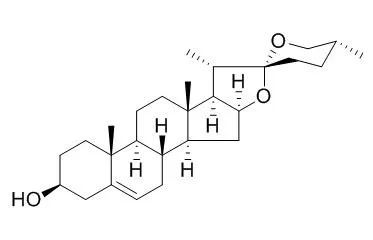| Description: |
Diosgenin possesses antivascular calcification , anti-osteoclastogenesis, anti-inflammatory and anticancer properties, it has favorable effects in the improvement of diabetes and regulation of lipid metabolism. Diosgenin treated inflammation-related disorders through the blockade of cAMP, PKA, cPLA2, PAK, Akt and MAPKs signaling pathways. Diosgenin may decrease the risk of developing dementia of opiate abusers with HIV infection and the ApoE4 allele. |
| In vitro: |
| Oncogene. 2006 Mar 9;25(10):1463-73. | | Diosgenin inhibits osteoclastogenesis, invasion, and proliferation through the downregulation of Akt, I kappa B kinase activation and NF-kappa B-regulated gene expression.[Pubmed: 16331273 ] | Diosgenin, a steroidal saponin present in fenugreek (Trigonella foenum graecum) and other plants, has been shown to suppress inflammation, inhibit proliferation, and induce apoptosis in a variety of tumor cells, but through a mechanism that is poorly understood.
METHODS AND RESULTS:
In the present study, we report that Diosgenin inhibits receptor-activated nuclear factor-kappaB ligand-induced osteoclastogenesis, suppresses tumor necrosis factor (TNF)-induced invasion, and blocks the proliferation of tumor cells, all activities known to be regulated by NF-kappaB. Diosgenin suppressed TNF-induced NF-kappaB activation as determined by DNA binding, activation of IkappaBalpha kinase, IkappaBalpha phosphorylation, IkappaBalpha degradation, p65 phosphorylation, and p65 nuclear translocation through inhibition of Akt activation. NF-kappaB-dependent reporter gene expression was also abrogated by Diosgenin. TNF-induced expression of NF-kappaB-regulated gene products involved in cell proliferation (cyclin D1, COX-2, c-myc), antiapoptosis (IAP1, Bcl-2, Bcl-X(L), Bfl-1/A1, TRAF1 and cFLIP), and invasion (MMP-9) were also downregulated by the saponin. Diosgenin also potentiated the apoptosis induced by TNF and chemotherapeutic agents.
CONCLUSIONS:
Overall, our results suggest that Diosgenin suppresses proliferation, inhibits invasion, and suppresses osteoclastogenesis through inhibition of NF-kappaB-regulated gene expression and enhances apoptosis induced by cytokines and chemotherapeutic agents. | | Neurobiol Dis. 2006 Jul;23(1):109-19. | | Increased vulnerability of ApoE4 neurons to HIV proteins and opiates: protection by diosgenin and L-deprenyl.[Pubmed: 16697650 ] | Human immunodeficiency virus (HIV) infection continues to rise in drug-abusing populations and causes a dementing illness in a subset of individuals. Factors contributing to the development of dementia in this population remain unknown.
METHODS AND RESULTS:
We found that HIV-infected individuals with the E4 allele of Apolipoprotein E (ApoE) or history of intravenous drug abuse had increased oxidative stress in the CNS. In vitro studies showed that HIV proteins, gp120 and Tat, Tat + morphine but not tumor necrosis factor-alpha (TNF-alpha), caused increased neurotoxicity in human neuronal cultures with ApoE4 allele. Microarray analysis showed a differential alteration of transcripts involved in energy metabolism in cultures of ApoE3 and 4 neurons upon treatment with Tat + morphine. This was confirmed using assays of mitochondrial function and exposure of the neurons to Tat + morphine. Using this in vitro model, we screened a number of novel antioxidants and found that only L-deprenyl and Diosgenin protected against the neurotoxicity of Tat + morphine. Furthermore, Tat-induced oxidative stress impaired morphine metabolism which could also be prevented by Diosgenin.
CONCLUSIONS:
In conclusion, opiate abusers with HIV infection and the ApoE4 allele may be at increased risk of developing dementia. L-deprenyl and a plant estrogen, Diosgenin, may have therapeutic potential in this population. | | Bioorg Med Chem . 2015 Nov 15;23(22):7324-31. | | Bivalent ligands incorporating curcumin and diosgenin as multifunctional compounds against Alzheimer's disease[Pubmed: 26526742] | | Abstract
In an effort to combat the multifaceted nature of Alzheimer's disease (AD) progression, a series of multifunctional, bivalent compounds containing curcumin and Diosgenin were designed, synthesized, and biologically characterized. Screening results in MC65 neuroblastoma cells established that compound 38 with a spacer length of 17 atoms exhibited the highest protective potency with an EC50 of 111.7 ± 9.0 nM. A reduction in protective activity was observed as spacer length was increased up to 28 atoms and there is a clear structural preference for attachment to the methylene carbon between the two carbonyl moieties of curcumin. Further study suggested that antioxidative ability and inhibitory effects on amyloid-β oligomer (AβO) formation may contribute to the neuroprotective outcomes. Additionally, compound 38 was found to bind directly to Aβ, similar to curcumin, but did not form complexes with the common biometals Cu, Fe, and Zn. Altogether, these results give strong evidence to support the bivalent design strategy in developing novel compounds with multifunctional ability for the treatment of AD.
Keywords: Alzheimer’s disease; Bivalent strategy; Caprospinol; Curcumin; Diosgenin; Natural products. |
|
| In vivo: |
| Free Radic Res. 2014 Dec;48(12):1485-93. | | Diosgenin inhibits superoxide generation in FMLP-activated mouse neutrophils via multiple pathways.[Pubmed: 25246240] | Diosgenin possesses anti-inflammatory and anticancer properties. Activated neutrophils produce high concentrations of the superoxide anion which is involved in the pathophysiology of inflammation-related diseases and cancer.
METHODS AND RESULTS:
In the present study, the inhibitory effect and possible mechanisms of Diosgenin on superoxide generation were investigated in mouse bone marrow neutrophils. Diosgenin potently and concentration-dependently inhibited the extracellular and intracellular superoxide anion generation in Formyl-Met-Leu-Phe (FMLP)- activated neutrophils, with IC50 values of 0.50 ± 0.08 μM and 0.66 ± 0.13 μM, respectively. Such inhibition was not mediated by scavenging the superoxide anion or by a cytotoxic effect. Diosgenin inhibited the phosphorylation of p47phox and membrane translocation of p47phox and p67phox, and thus blocking the assembly of nicotinamide adenine dinucleotide phosphate oxidase. Moreover, cellular cyclic adenosine monophosphate (cAMP) levels and protein kinase A (PKA) expression were also effectively increased by Diosgenin. It attenuated FMLP-induced increase of phosphorylation of cytosolic phospholipase A (cPLA2), p21-activated kinase (PAK), Akt, p38 mitogen-activated protein kinase (p38MAPK), extracellular signal-regulated kinase (ERK1/2), and c-Jun N-terminal kinase (JNK). Our data indicate that Diosgenin exhibits inhibitory effects on superoxide anion production through the blockade of cAMP, PKA, cPLA2, PAK, Akt and MAPKs signaling pathways.
CONCLUSIONS:
The results may explain the clinical implications of Diosgenin in the treatment of inflammation-related disorders. |
|






 Cell. 2018 Jan 11;172(1-2):249-261.e12. doi: 10.1016/j.cell.2017.12.019.IF=36.216(2019)
Cell. 2018 Jan 11;172(1-2):249-261.e12. doi: 10.1016/j.cell.2017.12.019.IF=36.216(2019) Cell Metab. 2020 Mar 3;31(3):534-548.e5. doi: 10.1016/j.cmet.2020.01.002.IF=22.415(2019)
Cell Metab. 2020 Mar 3;31(3):534-548.e5. doi: 10.1016/j.cmet.2020.01.002.IF=22.415(2019) Mol Cell. 2017 Nov 16;68(4):673-685.e6. doi: 10.1016/j.molcel.2017.10.022.IF=14.548(2019)
Mol Cell. 2017 Nov 16;68(4):673-685.e6. doi: 10.1016/j.molcel.2017.10.022.IF=14.548(2019)